How to programmatically click a button in WPF?
Solution 1
WPF takes a slightly different approach than WinForms here. Instead of having the automation of a object built into the API, they have a separate class for each object that is responsible for automating it. In this case you need the ButtonAutomationPeer to accomplish this task.
ButtonAutomationPeer peer = new ButtonAutomationPeer(someButton);
IInvokeProvider invokeProv = peer.GetPattern(PatternInterface.Invoke) as IInvokeProvider;
invokeProv.Invoke();
Here is a blog post on the subject.
Note: IInvokeProvider interface is defined in the UIAutomationProvider assembly.
Solution 2
Like JaredPar said you can refer to Josh Smith's article towards Automation. However if you look through comments to his article you will find more elegant way of raising events against WPF controls
someButton.RaiseEvent(new RoutedEventArgs(ButtonBase.ClickEvent));
I personally prefer the one above instead of automation peers.
Solution 3
if you want to call click event:
SomeButton.RaiseEvent(new RoutedEventArgs(Button.ClickEvent));
And if you want the button looks like it is pressed:
typeof(Button).GetMethod("set_IsPressed", BindingFlags.Instance | BindingFlags.NonPublic).Invoke(SomeButton, new object[] { true });
and unpressed after that:
typeof(Button).GetMethod("set_IsPressed", BindingFlags.Instance | BindingFlags.NonPublic).Invoke(SomeButton, new object[] { false });
or use the ToggleButton
Solution 4
this.PowerButton.RaiseEvent(new RoutedEventArgs(Button.ClickEvent));
Solution 5
One way to programmatically "click" the button, if you have access to the source, is to simply call the button's OnClick event handler (or Execute the ICommand associated with the button, if you're doing things in the more WPF-y manner).
Why are you doing this? Are you doing some sort of automated testing, for example, or trying to perform the same action that the button performs from a different section of code?
Related videos on Youtube
soldy
Updated on August 22, 2021Comments
-
 soldy over 2 years
soldy over 2 yearsWhat is the correct way to extend build-in components of MaterialUI v5? What I'd like to do:
- Style the build-in component
- Make a wrapper on top of my styled component with additional components
The current code:
import {Box, Link, LinkProps} from '@mui/material'; import {styled} from '@mui/material/styles'; const StyledLink = styled(Link)<LinkProps>({ display: 'flex', flexDirection: 'column', alignItems: 'center', color: '#6b7688', fontWeight: 500, fontSize: '12.8px', textTransform: 'uppercase', textDecoration: 'none', '&:hover, &.Mui-focusVisible': { color: '#313bac', transition: 'all 0.3s ease-in-out', // LinkHoverElement '& .MuiBox-root': { backgroundColor: '#313bac', }, }, }); const LinkHoverElement = styled(Box)({ width: '5px', height: '5px', marginBottom: '5px', borderRadius: '50%', backgroundColor: 'transparent', }); const MenuLink = ({children, ...restProps}: LinkProps) => { return ( <StyledLink {...restProps}> <LinkHoverElement /> {children} </StyledLink> ); }; export default MenuLink;It works, I also may use all props ('sx' prop as well)
<MenuLink sx={{mx: '1rem'}} key={page} href={`#${page}`}> {page} </MenuLink>seems like a 'god object', I've read documentation and uses this articles:
but haven't found an complicated example and feel like the code above isn't a best practice
-
tghoang about 15 yearsIt's not the only solution to my problem, but when I tried to do this, I found that it's not as easy as button.PerformClick(), so just a bit curious... :)
-
Greg D about 15 yearsSlick, I wasn't aware of this. Could be very useful for automated testing. Note that there's a comment on that link which suggests using a provided factory to get the automation peer instead of creating one yourself.
-
 Eduardo Molteni over 14 yearsThe RaiseEvent solution only raises the event. It does not execute the Command associated with the Button (as Skanaar say)
Eduardo Molteni over 14 yearsThe RaiseEvent solution only raises the event. It does not execute the Command associated with the Button (as Skanaar say) -
Phil Green almost 14 yearsIf you use XAML eg <Button Name="X" Click="X_Click" />, the event will be caught by the on click handler as per normal. +1 from me!
-
Mageician about 12 yearsI'm using VB...not sure if the code is different for VB verses C#, but
new RoutedEventArgs(Button.ClickEvent)didn't work for me. I had to usenew RoutedEventArgs(Primitives.ButtonBase.ClickEvent). Otherwise, works great! -
Justin Pihony almost 12 yearsTo elaborate on @EduardoMolteni and Skanaar, you lose the IsEnabled functionality given by Commands this way, so unless you want all of your events to check if they are enabled, the AutomationPeer works better.
-
 robi-y about 11 yearsIf this is a ToggleButton: button.IsChecekd = false/true; seems to be enough
robi-y about 11 yearsIf this is a ToggleButton: button.IsChecekd = false/true; seems to be enough -
 MEMark over 10 yearsI would change the second line to
MEMark over 10 yearsI would change the second line toIInvokeProvider invokeProv = (IInvokeProvider)peer.GetPattern( PatternInterface.Invoke );since you know that this cast should always be valid. -
sergeantKK over 9 yearsThanks for this. I struggled to find the correct namespaces in my app, until I added a reference to
UIAutomationProvider. Then had to addusing System.Windows.Automation.Peers; using System.Windows.Automation.Provider; -
 Danny Beckett over 9 yearsA one-liner for the inclined:
Danny Beckett over 9 yearsA one-liner for the inclined:((IInvokeProvider) (new ButtonAutomationPeer(someButton).GetPattern(PatternInterface.Invoke)).Invoke(); -
denver about 9 yearsOne thing to note is that the Invoke call is asynchronous. That means if you are using it in a unit test and your next line is to check the expected result of clicking the button, you might have to wait.
-
 Cool Blue over 7 yearsThis is a good way to use an event from a child element to fire a command on a parent.
Cool Blue over 7 yearsThis is a good way to use an event from a child element to fire a command on a parent. -
 Steven Rands over 7 yearsJust for reference, the
Steven Rands over 7 yearsJust for reference, theIInvokeProviderinterface is defined in theUIAutomationProviderassembly. -
 Andrea Antonangeli almost 7 yearsI had to click on the menu of another window in the same project, and MyOtherWindow.mnuEntry_Click(Me, New Windows.RoutedEventArgs) did it. Really simple.
Andrea Antonangeli almost 7 yearsI had to click on the menu of another window in the same project, and MyOtherWindow.mnuEntry_Click(Me, New Windows.RoutedEventArgs) did it. Really simple. -
KVKConsultancy over 5 yearsOne note, this only triggers the effect the button will have if clicked. It does not generate any click events in the message dispatching queue. For all practical cases this is what you will desire and will avoid unnecessary dispatcher events (e.g. more performant) but if your actually somehow requiring the dispatcher events other solutions above are more appropriate
-
Hassaan Raza almost 4 yearswhat does some button reffers to?
-
Zhong W over 3 yearsIt saves my day.







